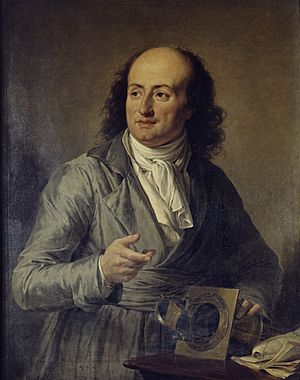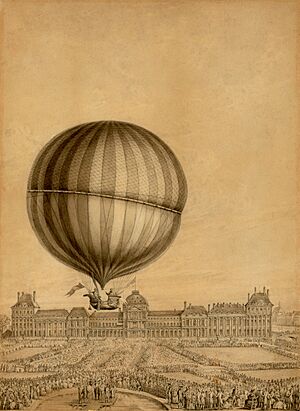Jacques Charles facts for kids
Quick facts for kids
Jacques Charles
|
|
|---|---|

Portrait by Adélaïde Labille-Guiard, c. 1798
|
|
| Born | 12 November 1746 Beaugency, France
|
| Died | 7 April 1823 (aged 76) |
| Nationality | French |
| Known for | Charles's law |
| Scientific career | |
| Fields | physics mathematics hot air ballooning |
| Institutions | Académie des Sciences |
Jacques Alexandre César Charles (born November 12, 1746 – died April 7, 1823) was a French inventor, scientist, mathematician, and balloonist. He is best known for his work with hydrogen balloons and for a gas law named after him.
In August 1783, Charles and the Robert brothers launched the world's first unmanned hydrogen-filled gas balloon. Later, in December 1783, Charles and his co-pilot Nicolas-Louis Robert flew in a manned gas balloon. They reached a height of about 1,800 feet (550 meters). Because they were the first to use hydrogen for lift, this type of balloon was called a Charlière. This was different from a Montgolfière, which used hot air.
Charles's law explains how gases expand when they are heated. This law was officially written down by Joseph Louis Gay-Lussac in 1802. However, Gay-Lussac gave credit to Jacques Charles for his earlier, unpublished work on the topic.
Charles became a member of the Académie des Sciences in 1795. He later became a professor of physics there.
Contents
Life of Jacques Charles
Jacques Charles was born in Beaugency-sur-Loire in 1746. He married Julie Françoise Bouchaud des Hérettes. She was 37 years younger than him. Charles lived longer than his wife. He passed away in Paris on April 7, 1823.
Pioneering Hydrogen Balloon Flights
First Unmanned Hydrogen Balloon
Jacques Charles thought that hydrogen would be a good gas to make balloons float. He had studied the work of Robert Boyle and his Boyle's Law, which was published many years earlier. He also learned from other scientists like Henry Cavendish.
Charles designed the balloon. Then, he worked with the Robert brothers, Anne-Jean and Nicolas-Louis, to build it. They built it in their workshop in Paris. The brothers found a way to make the balloon's gas bag light and airtight. They did this by dissolving rubber in a liquid called turpentine. Then, they painted this mixture onto sheets of silk. These silk sheets were sewn together to make the main balloon. They used red and white silk strips. But the rubber coating made the balloon look red and yellow.
On August 27, 1783, Jacques Charles and the Robert brothers launched the world's first hydrogen-filled balloon. It took off from the Champ de Mars in Paris, where the Eiffel Tower now stands. Many people watched, including Benjamin Franklin.
This balloon was quite small. It was a 35 cubic meter sphere made of rubberized silk. It could only lift about 9 kilograms (20 pounds). To fill it, they poured almost a quarter of a tonne of sulphuric acid onto half a tonne of scrap iron. This process created the hydrogen gas. The gas went into the balloon through lead pipes. It was hard to fill the balloon completely because the gas was hot when made. As it cooled inside the balloon, it shrank.
People were so excited that daily updates were given on the balloon's filling. There were so many people that the balloon was secretly moved at night to the Champ de Mars. It was moved about 4 kilometers away.
The balloon flew north for 45 minutes. People on horseback chased it. It landed 21 kilometers away in the village of Gonesse. The local farmers were reportedly scared. They destroyed the balloon with pitchforks or knives. The money for this project came from donations organized by Barthelemy Faujas de Saint-Fond.
First Manned Hydrogen Balloon Flight
On December 1, 1783, at 1:45 PM, Jacques Charles and the Robert brothers launched a new manned balloon. It took off from the Jardin des Tuileries in Paris. Jacques Charles flew with Nicolas-Louis Robert as his co-pilot. This hydrogen-filled balloon was 380 cubic meters in size. It had a valve to release hydrogen and a net that held the basket. They used sand to control how high they flew.
They went up to about 1,800 feet (550 meters). They landed at sunset in Nesles-la-Vallée. Their flight lasted 2 hours and 5 minutes and covered 36 kilometers. People on horseback, led by the Duc de Chartres, held the balloon down. Both Charles and Nicolas-Louis then got out.
Jacques Charles then decided to go up again, but this time he went alone. The balloon had lost some hydrogen. This time, it quickly went up to about 3,000 meters. He saw the sun again from that height. He started to feel pain in his ears. So, he opened the valve to let out gas. He then landed gently about 3 kilometers away. Unlike the Robert brothers, Charles never flew in a balloon again. However, hydrogen balloons were named Charlière in his honor.
It is said that 400,000 people watched the launch. Hundreds of them paid to get a "special enclosure" for a closer view. Benjamin Franklin, who represented the United States of America, was among them. Joseph Montgolfier was also there. Charles honored him by asking him to release a small, bright green pilot balloon. This was done to check the wind and weather.
This flight happened ten days after the world's first manned balloon flight. That first flight was by Jean-François Pilâtre de Rozier using a Montgolfier brothers hot air balloon.
More Ballooning Adventures
Jacques Charles and the Robert brothers then worked on building a longer, steerable balloon. This design followed ideas from Jean Baptiste Meusnier. He had suggested a balloon that could be steered. Their design included internal air cells (called ballonnets), a rudder, and a way to move the balloon forward.
Jacques Charles never flew in this new craft. But on July 15, 1784, the brothers flew it for 45 minutes. They flew from Saint-Cloud to Meudon with M. Collin-Hullin and Louis Philippe II, the Duke of Chartres. This balloon was called La Caroline. It had oars to help with movement and direction, but these did not work well. The balloon did not have a gas release valve. So, the duke had to cut the ballonnet to stop the balloon from bursting when they reached about 4,500 meters high.
On September 19, 1784, the Robert brothers and M. Collin-Hullin flew for 6 hours and 40 minutes. They covered 186 kilometers from Paris to Beuvry. This was the first balloon flight to go over 100 kilometers.
Charles's Inventions
Charles created several useful inventions. He designed a valve to let hydrogen out of balloons. He also invented other tools, like the hydrometer and the reflecting goniometer. He improved the Gravesand heliostat and Fahrenheit's aerometer. In addition, he confirmed some of Benjamin Franklin's experiments with electricity.
Understanding Charles's Law
Charles's law (also known as the law of volumes) describes how gases expand when they are heated. This law was first published by scientist Joseph Louis Gay-Lussac in 1802. However, Gay-Lussac gave credit to Jacques Charles for his earlier, unpublished work. He named the law in Charles's honor.
Around 1787, Charles did an experiment. He filled five balloons with different gases, all to the same volume. He then raised the temperature of the balloons to 80°C. He noticed that all the balloons increased in volume by the same amount. Gay-Lussac mentioned this experiment in 1802 when he wrote about the exact relationship between a gas's volume and its temperature.
Charles's law states that if the pressure stays the same, the volume of an ideal gas is directly related to its absolute temperature. This means that as the temperature of a gas increases, its volume also increases in a straight line. The formula he created was V1/T1 = V2/T2.
Charles's Career and Recognition
Jacques Charles was chosen to be a member of the American Philosophical Society in 1786. He also joined the Académie des Sciences in 1795. After that, he became a professor of physics at the Conservatoire des Arts et Métiers.
Remembering Charles's Legacy
A stone monument (called a stele) in Nesles-la-Vallée marks the Charles-Robert flight of December 1, 1783. You can see an image of this monument here.
The Coupe Charles et Robert was an international ballooning event. It was held in 1983 at the same time as the Gordon Bennett Cup.
See also
 In Spanish: Jacques Charles para niños
In Spanish: Jacques Charles para niños
- Gas laws
- Timeline of hydrogen technologies
- Jean-François Pilâtre de Rozier, who made the first manned balloon flight using a Montgolfier hot-air balloon, 10 days before La Charlière.
- Jean-Pierre Blanchard
- Timeline of aviation - 18th century
- History of ballooning
- List of firsts in aviation



